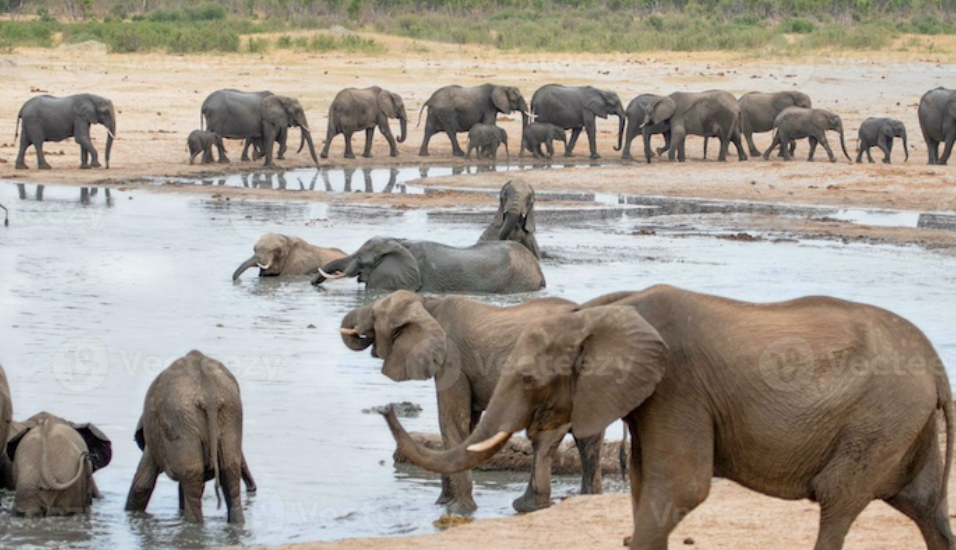Zimbabwe Plans to Cull 200 Elephants Amid Drought (GS Paper 3, Wildlife Conservation)

Context
- On September 19, 2024, the Zimbabwean government announced its plan to cull 200 elephants in response to a severe drought affecting both wildlife and human populations.
- This decision reflects a challenging balancing act: protecting the livelihoods of local communities while addressing the ecological consequences of overpopulation within the elephant population.
Elephant Overpopulation: A Critical Concern
Zimbabwe is currently home to approximately 84,000 elephants, a number that significantly exceeds the environment's sustainable capacity of around 45,000. This overpopulation presents a myriad of challenges:
- Resource Depletion: With the land struggling to support such a large number of elephants, critical resources like food and water become increasingly scarce. This forces elephants to migrate beyond their natural habitats in search of sustenance, leading to greater competition for limited resources.
- Human-Wildlife Conflict: As elephants venture into human settlements, conflicts arise. Incidents of elephants damaging crops, property, and even posing physical threats to residents have increased. Tragically, there have been reports of fatal encounters, heightening fears among communities living in proximity to elephant habitats.
Government Initiatives
Zimbabwe’s Environment Minister, Sithembiso Nyoni, highlighted the urgency of the elephant overpopulation crisis during parliamentary discussions. The government is actively seeking solutions to manage the situation, drawing inspiration from Namibia’s recent initiatives that involve culling as a method to address similar issues stemming from drought conditions.
The proposed culling aims to:
- Reduce the Elephant Population: By removing 200 elephants, the government hopes to bring the population closer to sustainable levels, thereby alleviating pressure on resources.
- Mitigate Human-Wildlife Conflicts: Reducing the number of elephants may decrease the frequency of dangerous encounters, protecting both human lives and property.
Opposition to Culling
The announcement to cull elephants has sparked significant backlash from wildlife advocates, conservationists, and various non-governmental organizations (NGOs). Their main arguments include:
- Ethical Concerns: Critics argue that killing elephants is inhumane and undermines conservation efforts aimed at protecting endangered species. They believe non-lethal methods should be prioritized.
- Potential Consequences: Opponents warn that culling could lead to a rise in illegal hunting for bushmeat, as the demand for food rises in affected communities. There are fears that this may destabilize local ecosystems even further.
- Alternative Solutions: Many conservationists advocate for strategies such as relocating elephants to less populated areas, enhancing habitat management, and employing community education programs about coexisting with wildlife.
Human-Wildlife Conflict
- The increasing interactions between elephants and humans have raised pressing safety concerns.
- Fatal encounters have underscored the urgency for intervention.
- Culling, in this context, is seen by some as a necessary measure to protect communities from aggressive elephant behaviors that can lead to injury or death.
International Context and Climate Change
The decision to cull elephants in Zimbabwe is not an isolated incident. Namibia has also initiated similar culling practices in light of drought and food scarcity. Both nations face challenges linked to climate change, including:
- Drought Conditions: Extended periods of drought have significantly impacted agriculture, forcing communities to grapple with food shortages. As elephants deplete available resources, the situation becomes even more dire for both wildlife and people.
- Weather Patterns: Irregular weather patterns, exacerbated by climate change phenomena such as El Niño, disrupt traditional farming practices, leading to a food crisis that heightens tensions between humans and wildlife.
Implementation and Focus Areas
- The culling process will begin once all legal and administrative preparations are complete.
- The focus will primarily be on areas where the elephant population is particularly dense, as these regions tend to experience the highest levels of conflict with human communities.
- By strategically targeting these areas, the government hopes to achieve a more sustainable balance between wildlife conservation and human safety.
Conclusion
- Zimbabwe’s decision to cull elephants amidst drought conditions raises critical ethical, ecological, and social questions.
- While the culling aims to alleviate food shortages and reduce human-wildlife conflicts, it highlights the complex interplay between environmental sustainability and community welfare.
- The international community’s response to Zimbabwe’s actions will likely influence future policies on wildlife management and conservation strategies.
- As the country navigates these challenges, it must consider the long-term implications of its decisions on both its natural heritage and the lives of its citizens.
- The situation serves as a poignant reminder of the urgent need for comprehensive, humane, and sustainable approaches to wildlife management, especially in the face of climate-induced pressures.


